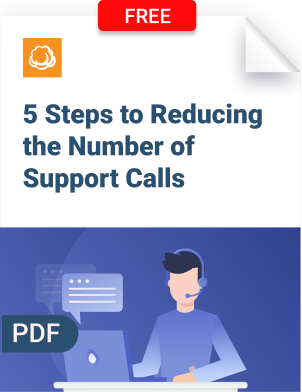Imagine that you have just lost a customer. While this is not a reason for an immediate panic attack, customers leave and it’s the reality for every business, this is a sign that not all processes in your managed IT business are running smoothly.
Further in the article, we will discuss how you can investigate why your customers are leaving, several of the most probable reasons behind it, and what actions you should take to avoid losing the rest of your clientele.
Define the Churn Rate
Churn rate is an indicator showing how many customers are leaving, against those who stay with you. Here’s the formula to calculate it:
- CR = (CS-CE)/CS * 100%
Where: - CR - the churn rate
- CS – the number of customers at the beginning of a period
- CE – the number of customers at the end of a period
Typically, the churn rate for shorter periods – days, weeks or months – is calculated based on high customer influx and turnover, which is feasible for businesses selling goods and services to a large number of end-users. In the managed IT sector, where customer turnover is not that high, you analyze churn quarterly, semi-annually and annually. If you notice a rising trend, it is time to assess the issue.
Although the metric is useful for bigger MSPs with dozens of contracted clients, it’s pointless to calculate churn rate for a one-man/woman show where the number of clients typically stays around 10-15 and doesn’t change that much over the year. It’s better to monitor the situation continuously in this situation.
Ask Your Customers
Talk to the Customers Who Have Already Left
The first source of information is a customer who has already left you. You have turned that customer from a prospect into a real-life client once, but they have moved on. You should understand and analyze the reason behind that.
- Review the support cases and projects that you’ve worked on for that client. It might turn out that they left for obvious reasons, like longer-than-expected ticket resolution times or lost backup data.
- Talk to the support staff responsible for the cases at the time to find out if there were any repeatable issues you didn’t notice during the previous step.
- Meet the client in person or call them and ask as many questions as possible.
Note everything that you have learned about your ex-customers' experience and consider making adjustments in your processes.
Talk to Your Existing Customers
While your existing customers may be happy with your services, they may still have thoughts and ideas to share. A periodical customer satisfaction survey is a good business practice and will give you valuable insights.
When the survey is completed – you’ve collected and analyzed the results – you should begin the in-depth interviews, either by phone or in person, with those who rated your prices, toolset or processes lower than you expected. With all that completed, you should have enough information to home in on the flaws in your managed IT has and identify the ones that need an immediate resolution.
The Typical Reasons That Customers Leave
Customers Don’t Like Your Prices
If your offer is unique and your operations are sound – there is no reason to keep prices low, as your clients will happily pay you for your services. Some will eventually leave for a lower price and, worse, a less thought-through offering, but more will stay with you. That is not a rare case; many MSPs out there are fanatical about what they are doing, and so thrive.
There are, however, two less-enjoyable possibilities:
- Your prices are high and services are not meeting expectations. That is a clear sign that you need to get back to the drawing board and reassess the processes that are going wrong.
- Your prices are high, services are great, but the competition is increasing in your area. If you’ve lost a couple of your previously loyal customers to either stellar-yet-cheaper newcomers or to bigger MSPs disrupting the prices, it's time to think about your price policy.
Further reading The Startup MSP’s Guide To Pricing
Customers Don’t Like Your Services
Running an MSP means you have a daily dose of troubling new cases. Your helpdesk staff are answering dozens of emails and phone calls, while you are busy outlining a couple of projects for a client who’s moving into a bigger office. There are, in other words, quite a few operations that can go wrong.

Some clients may accept flaws as inevitable, but others won’t tolerate continuous shortcomings and will look for better service elsewhere. Constant ignorance of service issues might eventually lead you to SLA payouts and loss of reputation, which, effectively, might be the first big step to bankruptcy. So, don’t hesitate to take immediate action:
- Fine-tune processes
- Re-evaluate the work of your staff
- Make adjustments to the service legal agreement if your current workflow does not allow you to meet it
Check our article on managing MSP projects for tips on how to approach MSP projects in a way that helps your business develop and keeps your clients happy.
It might turn out, however, that your services are fine, but there is one toxic customer who’s making all the fuss. If that is the case and the rest of your clients are happily working with you, let the annoying customer go. It will be a major relief for both you and your support team.
Customers Need More Up-To-Date Solutions
Some MSPs stop thinking outside the box while polishing their existing offer. For example, they are experts in local storage management and tape backup routines – recoveries are on time and zero bits of information has ever been lost – but these MSPs fail to recognize that cloud storage and archiving solutions are becoming so cheap, safe and reliable that their clients are looking at new and more demanding services. Some will still argue that there is no better place to store a backup than on a tape drive, but the business reality is different.
You can always find flaws in new approaches while improving old ones, but ignorance about new business and technology possibilities will leave you with only the most loyal customers, preventing your MSP from growing.
Further reading Cloud Based Storage vs Local Storage
Customers Need More Complex Solutions
Over time, your customers might thrive and grow, along with their operations and needs. Eventually, their infrastructure needs to become more interconnected and sophisticated, but you may not be ready to give them adequate technological advice or solutions. Thus you find yourself at a crossroads – whether to keep operations and the core customer as is, or to aim for bigger clients, which means widening your talent pool and your offering.
Growing for the sake of only one customer, on the other hand, might be dangerous. If you lose that contract, you will have to discontinue some operations or look for another profitable opportunity.
Further reading Going for Bigger Customers: Are You Ready?
It Just Happens
Businesses shut down all the time, operations are moved to other locations, the business owners may be in a bad mood; in other words, customers may leave you without an obvious reason. Let it go and don’t stop looking for new prospects.
Now It’s Your Turn
Keeping your churn rate at zero is an impossible task and clients will leave from time to time. There are two similarly dangerous mindsets you can have in this case:
- "We can fix everything, no client will ever leave us.” This approach typically leads to witch-hunts and nitpicking. Don’t lay into your team or overhaul your processes after a single incident.
- “Things happen, let’s move on.” This way, you stay in your comfort zone - and lose more clients over time. Similarly to failing to see new opportunities, ignorance of the fact that customers are leaving is the first step to stagnation.
It’s easy to lose track while dealing with all the uncertainty that’s tied with running an MSP business, so don’t be afraid to talk to your peers. The MSP space is full of people willing to help, who have encountered similar hurdles and are ready to share their insight with you.







